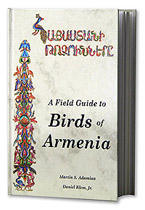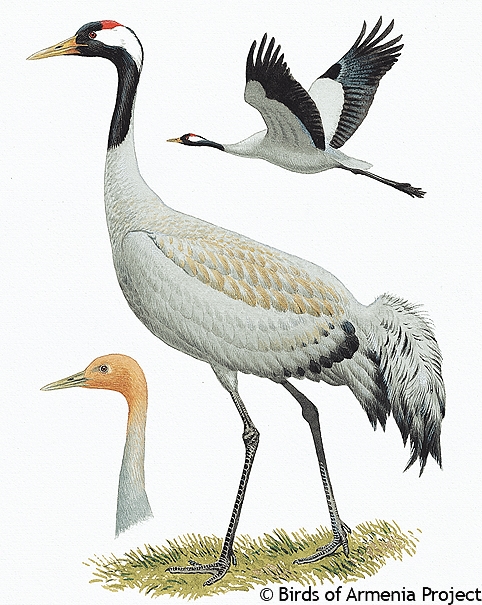- Pictures of All Birds
- Find Bird by Common Name
- Find Bird by Scientific Name
- Find Bird by Armenian Name
- Orders of Birds
- Distribution Maps
- Location of Armenia
- Species of Special Concern

Purchase the Field Guide
© Copyright Birds
of Armenia Project

| Armenian Name: | Մոխրագույն կռունկ |
|---|---|
| Species Status: | Threatened Species - Species of Special Concern |

See Plate 3 for Common Crane and other similar species
| Resident Status: | Breeding bird |
|---|---|
| Abundance: | Uncommon |
| Length: | 110-120 cm, Wing Span:220-245 cm |
| Distribution Map: | Map 96. |
| Description: | Large bird with long neck and legs extended in flight; large tuft of plumes covers tail. |
| Adult: | Gray with black head with white stripe from side of head onto black neck; red crown patch and eye visible at close range. Often appears very pale at a distance. |
| Juvenile: | Orange-brown head and upper neck. |
| Similar Species: | Differs from Demoiselle Crane by larger size and gray lower neck and breast. Unlike herons, neck held straight in flight. |
| Behavior: | In flight, head, neck, and long legs appear to droop below body. Flight shows powerful wingbeats and long glides; soars on migration and flies in V-formation. Dancing display is characteristic in spring. |
| Habitat: | Mountain steppe with small wetlands, often adjacent to crop fields or meadows. |
| Food: | Plants, worms, insects, small vertebrates. |
| Nest: | Mound of vegetation with shallow cup, in marshes. |
| Eggs: | 94 mm, 2, pale yellow-brown or olive with red-brown spots. |